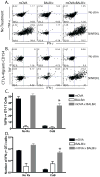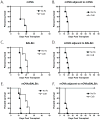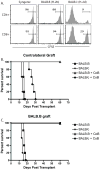High-frequency alloreactive T cells augment effector function of low-frequency CD8+ T-cell responses under CD28/CD154 blockade
- PMID: 20407401
- PMCID: PMC2935314
- DOI: 10.1097/TP.0b013e3181df53dc
High-frequency alloreactive T cells augment effector function of low-frequency CD8+ T-cell responses under CD28/CD154 blockade
Abstract
Background: Blockade of costimulatory molecules is a potent method of inducing long-term graft survival. We have previously addressed the issue of donor-reactive T-cell precursor frequency on relative costimulation dependence and found that the presence of a high precursor frequency of donor-reactive CD8 T cells resulted in costimulation blockade-resistant graft rejection, whereas the presence of a low-frequency donor-reactive population did not. To address the mechanisms by which high-frequency T cells obviated the requirement for costimulation, we asked whether a low-frequency population responding concomitantly with a high-frequency response also demonstrated costimulation independence.
Methods: A model system was established in which B6 mice containing a low frequency of anti-membrane bound chicken ovalbumin (mOVA) responders and a high frequency of anti-BALB/c responders received a skin graft from B6.mOVAxBALB/c F1 donors in the presence or absence of cytotoxic T-lymphocyte antigen-4 Ig/anti-CD154 costimulatory blockade.
Results: The results revealed that in the presence of costimulation blockade, high-frequency anti-BALB/c T cells augmented the effector activity of low-frequency anti-mOVA T cells, but it did not enhance the accumulation of anti-mOVA T cells capable of mediating graft rejection.
Conclusions: These results demonstrate that both antigen-specific and antigen-independent factors contribute to the relative costimulation independence of high-frequency T-cell responses.
Figures






Similar articles
-
Antigen-specific precursor frequency impacts T cell proliferation, differentiation, and requirement for costimulation.J Exp Med. 2007 Feb 19;204(2):299-309. doi: 10.1084/jem.20062319. Epub 2007 Jan 29. J Exp Med. 2007. PMID: 17261633 Free PMC article.
-
CD154 blockade alters innate immune cell recruitment and programs alloreactive CD8+ T cells into KLRG-1(high) short-lived effector T cells.PLoS One. 2012;7(7):e40559. doi: 10.1371/journal.pone.0040559. Epub 2012 Jul 5. PLoS One. 2012. PMID: 22792369 Free PMC article.
-
Modulation of costimulation by CD28 and CD154 alters the kinetics and cellular characteristics of corneal allograft rejection.Invest Ophthalmol Vis Sci. 2003 Sep;44(9):3899-905. doi: 10.1167/iovs.03-0084. Invest Ophthalmol Vis Sci. 2003. PMID: 12939307
-
Translating costimulation blockade to the clinic: lessons learned from three pathways.Immunol Rev. 2009 May;229(1):294-306. doi: 10.1111/j.1600-065X.2009.00776.x. Immunol Rev. 2009. PMID: 19426229 Free PMC article. Review.
-
Donor-reactive T-cell stimulation history and precursor frequency: barriers to tolerance induction.Transplantation. 2009 May 15;87(9 Suppl):S69-74. doi: 10.1097/TP.0b013e3181a2a701. Transplantation. 2009. PMID: 19424013 Free PMC article. Review.
Cited by
-
Differential requirements of CD4(+) T-cell signals for effector cytotoxic T-lymphocyte (CTL) priming and functional memory CTL development at higher CD8(+) T-cell precursor frequency.Immunology. 2013 Apr;138(4):298-306. doi: 10.1111/imm.12033. Immunology. 2013. PMID: 23113741 Free PMC article.
-
Alloimmunity But Not Viral Immunity Promotes Allograft Loss in a Mouse Model of Polyomavirus-Associated Allograft Injury.Transplant Direct. 2017 May 12;3(6):e161. doi: 10.1097/TXD.0000000000000677. eCollection 2017 Jun. Transplant Direct. 2017. PMID: 28620645 Free PMC article.
-
CD28 family and chronic rejection: "to belatacept...And beyond!".J Transplant. 2012;2012:203780. doi: 10.1155/2012/203780. Epub 2012 Jun 7. J Transplant. 2012. PMID: 22720132 Free PMC article.
-
Update on CD40 and CD154 blockade in transplant models.Immunotherapy. 2015;7(8):899-911. doi: 10.2217/IMT.15.54. Epub 2015 Aug 13. Immunotherapy. 2015. PMID: 26268734 Free PMC article. Review.
References
-
- Wirth T, Harty JT. Initial TCR transgenic precursor frequency alters functional behaviour of CD8 T cells responding to acute infection. Adv Exp Med Biol. 2009;633:71. - PubMed
-
- Hataye J, Moon JJ, Khoruts A, Reilly C, Jenkins MK. Naive and memory CD4+ T cell survival controlled by clonal abundance. Science. 2006;312 (5770):114. - PubMed
Publication types
MeSH terms
Substances
Grants and funding
LinkOut - more resources
Full Text Sources
Research Materials

